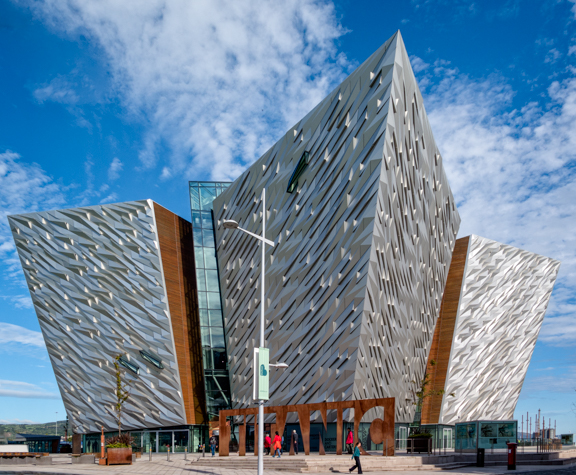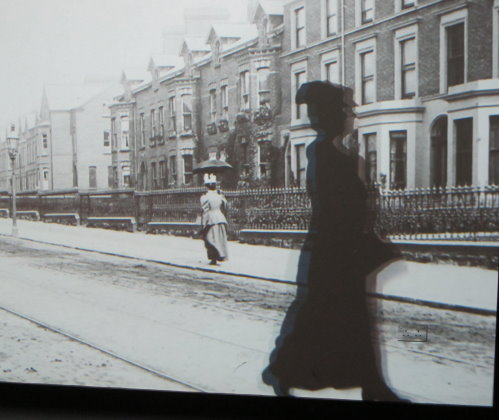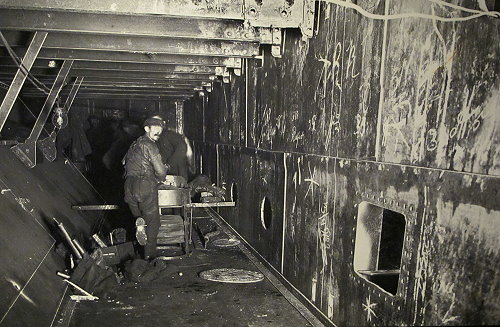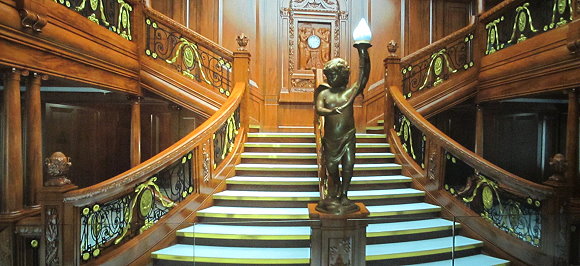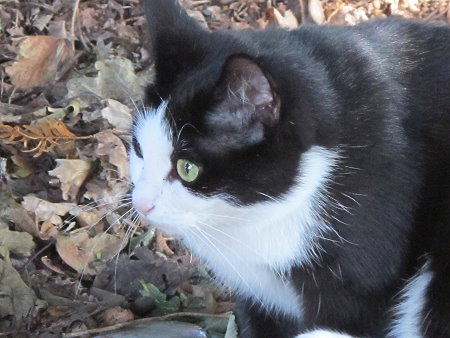If you noticed my absence last week, it was because Terry and I were in Northern Ireland. We have wanted to visit The Titanic Maritime Museum in Belfast for ages, and last week we finally got the chance. The museum is located on Queen’s Island, an area of land reclaimed from the water in the mid-19th century and a short walk from the centre of Belfast.
It's impossible to be unimpressed by this gigantic structure. This is no ordinary building, clad as it is with thousands of individual silver shards. Around its base are pools of water, which appear to be as deep and black as the Atlantic Ocean must have looked at 2.20am on April 15, 1912.
I’m sure the depth of the water is an illusion as there are neither warning signs nor guard rails.
I’m sure the depth of the water is an illusion as there are neither warning signs nor guard rails.
Looking up at this immense building, it is easy to imagine the iceberg that sent Titanic to her watery grave. I don’t know if the designers intended to give that impression, but it was certainly the feeling I got as I stood there.
The inside of the building is every bit as impressive as the outside.
The exhibition begins with an explanation of Belfast’s roots as an industrial centre. Life-size silhouettes are projected on to the walls to give an impression of daily life.
From here you are taken on a journey through the construction of the ship, her launch, a virtual tour of the decks and a peek inside a first, second and third class cabin.
One of the saddest parts of the exhibition is a gallery where the lighting is low and survivors’ voices (drawn from the BBC's archive) recall the horror of the sinking. As you listen, you are directed along a series of boards detailing some of the distress messages sent to and from Titanic.
Finally, screens beneath your feet take you on an underwater journey to the decaying remains in the Atlantic depths.
We thoroughly enjoyed our visit and are not surprised to learn Titanic Belfast has just been named Europe’s leading visitor attraction.
One of the saddest parts of the exhibition is a gallery where the lighting is low and survivors’ voices (drawn from the BBC's archive) recall the horror of the sinking. As you listen, you are directed along a series of boards detailing some of the distress messages sent to and from Titanic.
If you would like to find out more about the Titanic story there are numerous websites offering information. I found History.com and the BBC history websites especially interesting. The Titanic Belfast website is also well worth a look.
Or, if you are looking for an interesting read, I recommend Titanic and other ships written by Charles Herbert Lightoller (1874-1952). Published by Ivor Nicholson and Watson, London in 1935. Lightoller was the second mate (second officer) on board the Titanic and the only senior officer to survive the disaster. He was also the last man to be taken aboard the rescue ship RMS Carpathia. Just six of the thirty six chapters deal directly with his time on board the Titanic, but I found the rest of his life equally interesting. Titanic and other ships is available on ABE books at time of writing should you wish to look for a copy.
One final thing - a friend and reader of this blog asked me to keep a look out for the ship's cat. It pains me to say this but there was no sign of a cat. But then I googled Titanic - ship's cat, and found this;
It’s quite possible that there were multiple cats aboard the ship. Many large ships used them to monitor the rodent and pest problem that plagued the lower decks. The Titanic’s mascot and well-known ship's cat, Jenny, was one such cat.
One stoker, Jim Mulholland, volunteered to look after Jenny when she transferred from Titanic’s sister ship Olympia. It was rumoured that the cat had a litter of kittens a week before the ship left from Southampton. But what happened to Jenny on the morning of April 15, 1912?
Reports vary. Some say she, and her kittens died along with most of the passengers. However, others report Jim Mulholland observed Jenny unloading her kittens from the Titanic one by one before it left port in Southampton. He took this as a bad omen, picked up his things, and also left the vessel. He credited the cat with saving his life. (Source)
What really happened to Jenny is a mystery. But perhaps this feline photographed in Belfast’s Botanic gardens is one of her descendants?
0 Comments on The Ship's Cat & Titanic Belfast as of 9/19/2016 7:02:00 AM
Add a Comment





